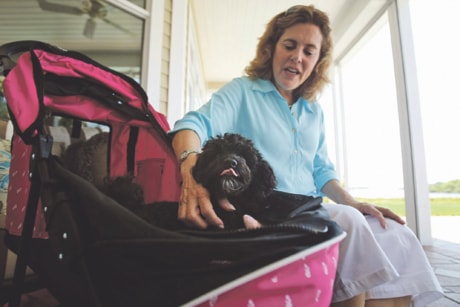MIAMI — Five-year-old Lucy the Labradoodle’s back limbs have been rendered unusable by rheumatoid arthritis, and she must scoot along the ground with her front paws to grab a bone. Her owners believe that a costly stem-cell treatment is the reason she’s even lived as long as she has.
In fact, they say, she seems to be improving.
She no longer yelps or whimpers in pain, and she needs far less medicine than before. Lucy’s owners credit the stem cell treatment, despite what experts say is a lack of evidence such treatments work.
“We didn’t think she’d live anywhere near this long, and I know it’s because of the stem cells,” says owner Carol Fischman, 57, of Vero Beach.
Thousands of dogs and horses with degenerative arthritis have had stem cell treatments, costing around US$2,500 to US$3,000 per procedure. There are no independent studies verifying their effectiveness, and some experts say such studies are needed to assess their potential.
University of Florida veterinarian Kristin Kirkby, who performed Lucy’s procedure, said that the outcomes on five similar treatments have all been positive. But that’s from owner-reported results, not scientific scrutiny.
Owners tell her their dogs have an easier time getting around the house and getting into position to urinate. Mostly, they just report their dogs appear to be more comfortable overall.
To get hard results, Kirkby says the university plans to start taking a pain inventory of each animal at the beginning of the process, followed by an evaluation and checkups afterward to measure changes.
“I think it’s an exciting field. Undoubtedly the future of scientific research is going this way,” Kirkby said. “It’s early on, especially in the small animal side, to know what the results can be.”
Vet-Stem, a Poway, Calif.-based company, is developing the stem cell therapy and began treating horses in 2003. It derives stem cells from fat samples taken from dogs and horses across the country.
The procedure has been used mainly to treat osteoarthritis, which involves loss of cartilage in the joints, but Vet-Stem is researching treatments for other diseases. Vet-Stem claims the therapy enables animals to replace cartilage and other tissue.
Since 2003, the privately held company has treated 3,500 horses and 1,500 dogs and plans to begin treating cats later this year. More than 1,500 vets are licensed to use the procedure.
Dr. Bob Harman, veterinarian and Vet-Stem founder, said it made sense to use these fat-based adult stem cells, which the body uses to create scar tissue and repair damage, to treat chronic disease in animals.
“Really, all we’re doing is harnessing the existing repair machinery in the body, concentrating it, and putting it right where an injury occurs, where healing is needed, to heal naturally,” he said
Adam Gassel has used stem cells to treat almost 40 dogs at his Irvine, Calif., veterinary clinic during the past two years.
“I was pretty skeptical,” he said. “I was hoping that dogs would just be more comfortable.”
But for about 25 per cent of dogs, their owners report they are like puppies again, able to get back to normal activities, he said. Another 25 per cent are able to stop taking medicines they were dependent upon. In all, Gassel said, all but 20 per cent of the animals show some positive response to the therapy, according to their owners and the requests for pain medicine.
One peer-reviewed study by researchers at Cornell University, published in the American Journal of Veterinary Research and sponsored in part by Vet-Stem, found that tendinitis in horses was improved by injection of the adult stem cells.
Two other studies published in Veterinary Therapeutics found that dogs with osteoarthritis showed improvements in lameness after stem cell injections.
Those studies also were sponsored by Vet-Stem and conducted by Vet-Stem researchers and other veterinarians.
Jonathan Slack, director of the University of Minnesota’s Stem Cell Research Institute, said adult stem cells from fat can become cartilage in a laboratory cell culture. Conclusive results on whether the stem-cell injection process actually makes new bone cells in animals don’t exist, to his knowledge.
“I guess from the dog’s point of view,” Slack said, “it’s good if it does work.”
Whatever the scientific merits of the therapies, Lucy’s owners say they would do it again for her.
She’s had her stem cell treatments through an IV three times, and the Fischmans want to give her a fourth one soon, despite the US$3,000-per-procedure cost.
“I like the dog as much as I like my kids,” said Dr. Charles Fischman, 59, who is an immunologist. “People will spend more on their dogs than they will on themselves.”
